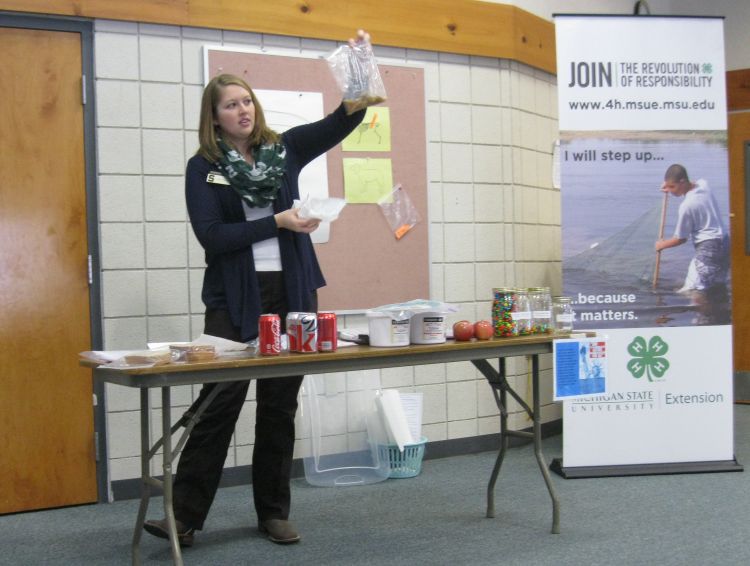Building the science back into 4-H animal science projects
Utilize these four free educational resources to help incorporate interactive learning activities for individual 4-H members or club meetings.

With cold weather outside, there are still plenty of great things that can be done indoors to help teach youth about science. Often times, if you ask youth if they learned science through raising an animal, their response would be no. Science is sometimes hard for youth to describe; however, youth are using science in almost all aspects of raising animals. Anatomy, physiology, biochemistry, chemistry, ethology (study of behavior), virology (study of viruses), bacteriology (study of bacteria), endocrinology (study of hormones) and many more, science plays a large role in animal production. For a further description of how science fits into animal science projects, view the “Showcasing the science in ‘animal science’” article from Michigan State University Extension.
To make defining science easier, the National Research Council released a report, “A Framework for K-12 Science Education.” Using this report, MSU Extension and Michigan 4-H are working to increase science literacy through the inclusion of the Scientific and Engineering Practices described in the framework. Whether a small or large setting, integrating education into 4-H member’s project areas allows for youth to be more engaged in their animal project and also apply new skills to their project. Moreover, MSU Extension offers many free resources to help teach youth at home or in a club setting the science found in our 4-H projects. These four resources will help increase science knowledge relating to the animal science project areas.
- Animal Science Anywhere lesson plans are designed to help 4-H volunteers engage 4-H youth at club meetings or events in learning more about the science and life skills involved in animal and veterinary science projects. The lessons are laid out with a full list of materials and are written to help leaders with varying degrees of expertise on the topics. Each lesson is designed to cost $10 and youth may work in teams or individually to accomplish the lesson objectives. Lessons are flexible, providing adaptations for various locations, ages and audiences. More lessons will be added throughout the year, but currently there are 14 free lessons available. Current 4-H Animal Science Anywhere lesson plans include:
- 4H1655 The Importance of Animal Identification Activity: That’s MY Apple!
- 4H1656 Anatomy and Physiology Activity: Locating Common Bones
- 4H1657 Sculpting Meat Science Activity: Creating and Evaluating Steaks
- 4H1658 Growth and Hormones Activity: Examining Growth Hormones in Beef
- 4H1659 Animal Digestion Activity: A Stomach At Work
- 4H1661 Biosecurity Activity: Basics of Biosecurity
- 4H1662 Identifying Cuts of Meat Activity: Pin the Meat Cut on the Animal
- 4H1663 Farm Animal Reproduction Activity
- 4H1664 Pathogen Activity: What Is a Pathogen?
- 4H1665 Diseases that Animals and Humans Share: The Words You Need to Know
- 4H1666 Mammary Gland Anatomy Activity
- 4H1667 Building on Biosecurity: Reducing the Risk
- 4H1668 Building Structurally Correct Animal Models
- 4H1669 Livestock Injection Methods and Placement
 Animal Care and Well-Being resources include bookmarks, posters and a guide to teach 4-H members, adults, parents and the general public about animal management and care practices. The bookmarks and posters answer commonly asked questions the general public may have while visiting a fair or animal exhibit while also providing talking points for youth. The Animal Care and Well-Being Guide was created to assist those who manage or participate in animal exhibition events. The guide includes three sections: guidelines for ensuring appropriate care of animals in a public setting, suggestions for educating the public about animals and animal agriculture, and recommendations for responding if demonstrations or animal-activist activity is present at your event.
Animal Care and Well-Being resources include bookmarks, posters and a guide to teach 4-H members, adults, parents and the general public about animal management and care practices. The bookmarks and posters answer commonly asked questions the general public may have while visiting a fair or animal exhibit while also providing talking points for youth. The Animal Care and Well-Being Guide was created to assist those who manage or participate in animal exhibition events. The guide includes three sections: guidelines for ensuring appropriate care of animals in a public setting, suggestions for educating the public about animals and animal agriculture, and recommendations for responding if demonstrations or animal-activist activity is present at your event.- 4-H Science Blast in the Class resources include 13 lessons relating to animal science, environmental science and plant science as well as a teacher’s guide. These resources are geared towards classroom instruction, but can be easily adapted to 4-H members at a club meeting.
- 4-H Science Blast Activities are intended for use in more general settings, such as 4-H club meetings and other youth development-focused events. The lesson plans are designed to help leaders teach youth science concepts and include instructions for three lessons. Videos or experiments are included in two of the three lessons.
Additionally, there are several volunteer trainings offered in Michigan throughout the year as well as more resources on the Michigan 4-H Resources page. There are also numerous curriculum resources available for purchase from the National 4-H Mall.



 Print
Print Email
Email



